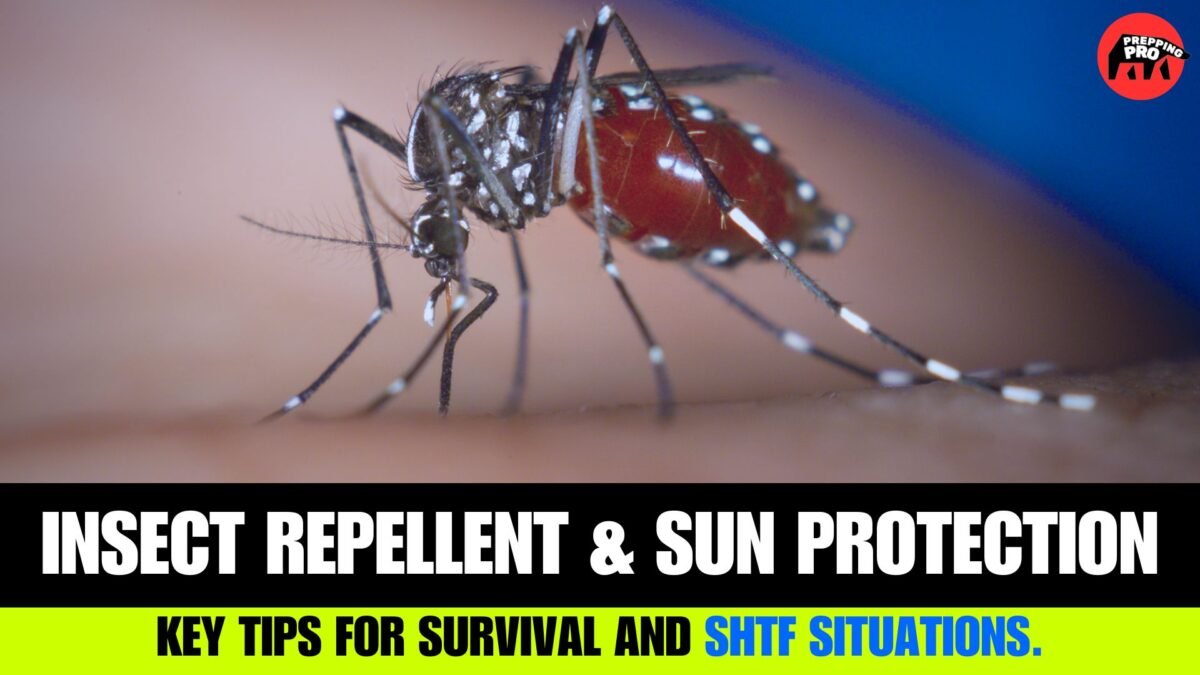Nearly 5 million Americans are reported to be treated for skin cancer each year, and many of these cases are attributed to overexposure to UV radiation.
In this article I will guide you through much-needed emergency insect repellent and sunscreen tips to make sure of your safety in the wild or during work outdoors.
Emergency insect repellent and sunscreen should also be included as a part of a complete home emergency kit. Check out our complete article on how to build one.
Key Takeaways:
- In emergencies, protecting oneself from the sun’s harmful UV rays and insect bites holds paramount importance.
- Appropriate sunscreens and insect repellents can provide effective protection.
- Application sequence matters: sunscreen first, repellent second, ensuring the efficacy of both products.
- Outdoor workers and adventurers should prioritize emergency preparations to tackle UV radiation and insect threats effectively.
- Reliable sunscreens are water-resistant, feature an SPF of 30 or more, and block both UVA and UVB radiation.
- DEET-based repellents and broad-spectrum coverage sunscreens are recommended for emergency needs.
Table of Contents
Understanding the Risks of Sun and Insect Exposure in Emergencies
Our environment can be a source of beauty but also a potential hazard, especially for those working or adventuring outdoors. The natural elements, such as the sun’s rays and insects, harbor risks that often come to light during emergencies. Understanding these threats is essential for effective emergency preparedness. Having to deal with the twin dangers of damaging UV radiation and insect-borne diseases, such as Lyme and West Nile, mandated the necessity of sun protection and insect repellent for emergency use.

The Threat of UV Radiation and Harmful Insects Outdoors
Direct exposure to the sun leads to harmful UV radiation penetrating the skin. Over time, this can lead to serious health issues such as skin aging, eye damage, immune system suppression, and even skin cancer. Additionally, outdoor adventures often bring us into contact with disease-carrying insects like mosquitoes and ticks. These pests can transmit infectious diseases that can have lasting effects on our health and wellbeing.
Emergency Preparedness for Outdoor Workers and Adventurers
Whether you’re a construction worker, a gardener, or an intrepid adventurer, proper emergency preparedness is critical. Selection of the right sunscreen and insect repellent, along with understanding their effective use, can provide the essential protection against the sun’s harmful rays and dangerous insects.
| Threat | Long-Term Effects | Preventive Measures |
|---|---|---|
| UV Radiation | Skin aging, eye damage, immunity suppression, skin cancer | Use of Sunscreen with high SPF value |
| Insect Bites | Transmission of diseases like Lyme and West Nile | Use of effective Insect Repellent |
In conclusion, adequate knowledge and preparedness can reduce the risks of sun and insect exposure in emergencies. By understanding how these threats function, you can ensure you’re always ready with your sun protection and insect repellent solution for emergency situations.
Best Practices for Emergency Sun Protection

In the world of outdoor activities, adventure seekers often overlook a crucial element, emergency sun protection, until they are faced with the harsh consequences of harmful UV exposure. It’s something that we, as outdoor enthusiasts or workers, need to take seriously to ensure our safety and health while in direct sunlight for prolonged periods.
One of the most effective approaches towards sun protection emergency use involves selecting a water-resistant sunscreen with an SPF of at least 30, known to block both UVA and UVB rays. As a general rule of thumb, experts recommend applying sunscreen at least 30 minutes before sun exposure to give it ample time to seep into the skin and start providing its protective shield.
“Application is a key factor that directly influences the effectiveness of sunscreens. If not applied generously, even a sunscreen with a high SPF might not offer the desired level of protection.”
You should aim to use a sufficient quantity of sunscreen that fully covers all your exposed skin. I cannot stress enough the importance of frequent reapplication. Ideally, sunscreen should be reapplied every two hours, or immediately after sweating or swimming to maintain an effective layer of protection.
- Select a water-resistant sunscreen with an SPF of at least 30
- Apply sunscreen at least 30 minutes before going out in the sun
- Ensure that all exposed skin is generously covered with the sunscreen
- Reapply sunscreen every two hours or immediately after excessive sweating or swimming
It’s very easy to forget to apply sunscreen in areas often overlooked, like the back of the neck, ears, and tops of the feet. It’s essential to make sure these areas are protected as well. Always have your emergency sun protection on hand when you’re out in the sun. It’s not just a best practice—it’s your safe shield against the harm caused by the sun’s potent UV rays.
| Sunscreen Application Tips | Select a water-resistant sunscreen | Apply 30 minutes before exposure |
|---|---|---|
| Use enough to cover all exposed skin | Don’t forget neck, ears, and feet |
Insect Repellent and Sun Protection for Emergency: Selecting the Right Products
When it comes to protecting yourself in emergency situations, DEET-based insect repellents are effective and water-resistant SPF is key for sunscreen.
The effectiveness of your emergency insect repellent and sun protection can make all the difference when you’re exposed to harsh sun rays and potentially dangerous insects.
Why DEET-Based Repellents are Effective for Emergencies
DEET-based repellents, known scientifically as N,N-Diethyl-meta-toluamide, are highly effective in repelling biting insects such as mosquitoes and ticks.
Since these insects are vectors for diseases like West Nile Virus and Lyme disease, safeguarding against their bites becomes crucial, especially in emergencies. Choosing repellents with DEET as an active ingredient can provide you with long-lasting, broad-spectrum protection.
However, it’s important to bear in mind that DEET concentration for usage by children should not exceed 30%. It is advised always to follow label instructions for safe application.
Choosing Water-Resistant Sunscreen with Appropriate SPF
Just like insect repellents, selecting an effective sunscreen for emergency use involves specific considerations.
An ideal emergency sun protection product should be water-resistant and have an SPF of 30 or higher.
Look for sunscreens offering ‘broad-spectrum’ coverage, which means they can protect your skin against both UVA and UVB rays. As with the repellent, it is key to use sunscreen as indicated on its label so as to ensure optimal sun protection.
| Product Category | Essential Features | Why it Matters? |
|---|---|---|
| Insect Repellent | DEET-Based, Concentration not exceeding 30% for children | Effective in repelling biting insects that may carry diseases |
| Sunscreen | Water-Resistant, SPF 30 or higher, Broad-Spectrum Coverage | Offers comprehensive protection against harmful UVA and UVB rays |
In conclusion, equipping yourself with the right emergency insect repellent and sun protection products can greatly reduce your vulnerability to the sun’s harmful rays and disease-carrying insects.
Therefore, selecting products with effective ingredients and appropriate protective qualities is of utmost importance.
Applying Sunscreen and Insect Repellent: Step-by-Step Guide
It’s crucial for outdoor safety to correctly apply both insect repellent and sun protection in emergency situations.
These guidelines can help you master this vital procedure and ensure optimal protection against the sun’s harmful UV rays and pesky insects that might carry diseases.
Step 1: Applying Sunscreen before Insect Repellent
Start the application sequence with sunscreen.
Apply it 30 minutes before heading outside. The amount should be equivalent to a shot glass to completely cover all exposed skin.
As per general guidelines, you should reapply every two hours. However, timings might change if you are swimming or sweating heavily. In such cases, you should reapply the sunscreen sooner.
Step 2: Timing and Method for Insect Repellent Application
Following the application of sunscreen, the second step is to use the insect repellent.
This should be done 10-20 minutes after the sunscreen application. Repellent use should be moderate—just a light coating.
Reapply only if necessary, or according to manufacturer’s instructions. Keep in mind that repellent should not be applied under clothing. Additionally, be cautious when applying to sensitive areas such as the face.
By following this step-by-step guide on how to correctly apply sunscreen and emergency insect repellent, you’ll ensure best possible effect from both products while enjoying your outdoor adventures.
Health Impact of DEET and Sunscreen Interaction
During an insect repellent emergency situation, DEET is the compound of choice because of its proven efficacy in repelling a variety of insects.
Meanwhile, during sunny days, sunscreen is our primary defense against the harmful ultraviolet rays of the sun. But what happens when these two substances interact?
As it turns out, DEET can reduce the effectiveness of sunscreen, leading to less than optimal sun protection.
This interaction necessitates a more frequent reapplication of sunscreen when used alongside DEET-based insect repellents.
However, leaving a brief gap between applications helps each product maintain its effectiveness without compromising the other.
It’s also important to note that products combining sunscreen and repellent should be avoided whenever possible.
This is because sunscreen typically needs more frequent application compared to insect repellent, especially during an emergency insect repellent and sunscreen situation.
Therefore, resorting to a combined product could potentially lead you to overexpose yourself to repellent chemicals.
| Product | Reapplication Frequency | Efficacy |
|---|---|---|
| Sunscreen Alone | Every 2 hours | High (If applied properly) |
| DEET-Based Insect Repellent Alone | As Per Requirements | High |
| Sunscreen and DEET-Based Insect Repellent (Separately) | More Frequent Sunscreen Application | Reduced (If not properly managed) |
| Combined Sunscreen and Insect Repellent Product | As Frequent as Sunscreen | Potential Overexposure to DEET |
To sum up; while both sunscreen and DEET-based insect repellent are quintessential items in our emergency sun and insect protection toolkit, it is crucial to ensure their proper and separate use.
As they say, prevention is better than cure, and this holds especially true in a scenario where you are faced with insect repellent emergency situation.
Conclusion
In preparing for any potential emergency scenarios, being proactive about sun protection and adopting an emergency insect repellent strategy are of paramount importance.
These measures protect against harmful UV rays and disease-carrying insects, thereby minimizing the risk of long-term health effects.
Priority should be given to the selection of appropriate products for both sun and insect protection.
Considerations include the effectiveness of DEET-based repellents and the broad-spectrum coverage of water-resistant sunscreens with an SPF of 30 or higher.
It’s equally important to understand the interaction between DEET and sunscreen. DEET can decrease the effectiveness of sunscreen, implying the need for a more frequent reapplication when the two are used concurrently.
This points to the need for diligent reapplication protocols to ensure the products remain effective.
Despite the potential challenges posed by remarkable interactions between these two types of products, following the correct application and reapplication guidelines can help ensure that you remain protected in any emergency situation.
Let’s navigate these situations proactively, armed with the right information and preparedness tactics.


